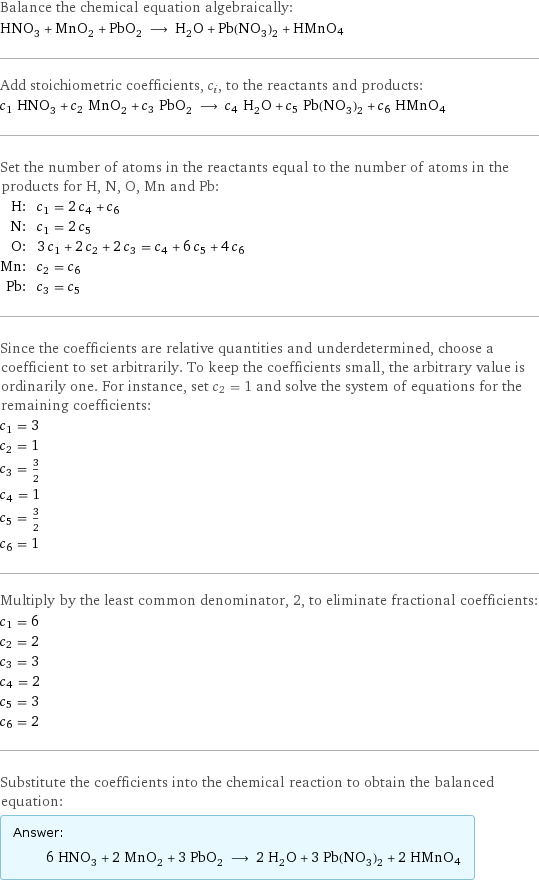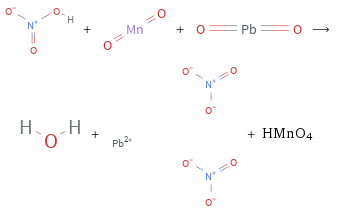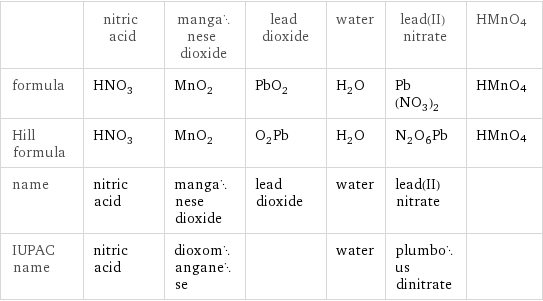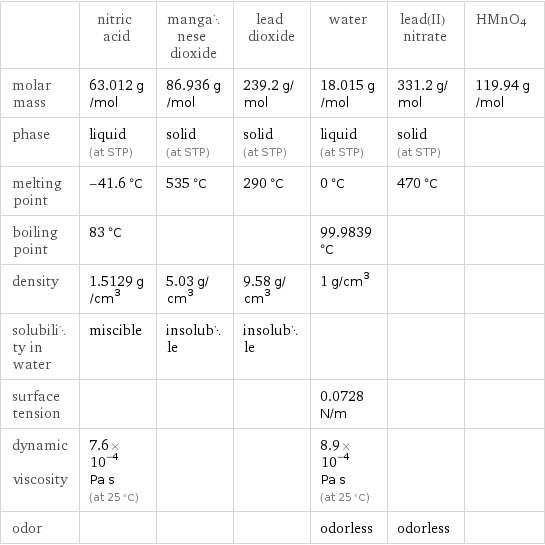Input interpretation

HNO_3 nitric acid + MnO_2 manganese dioxide + PbO_2 lead dioxide ⟶ H_2O water + Pb(NO_3)_2 lead(II) nitrate + HMnO4
Balanced equation

Balance the chemical equation algebraically: HNO_3 + MnO_2 + PbO_2 ⟶ H_2O + Pb(NO_3)_2 + HMnO4 Add stoichiometric coefficients, c_i, to the reactants and products: c_1 HNO_3 + c_2 MnO_2 + c_3 PbO_2 ⟶ c_4 H_2O + c_5 Pb(NO_3)_2 + c_6 HMnO4 Set the number of atoms in the reactants equal to the number of atoms in the products for H, N, O, Mn and Pb: H: | c_1 = 2 c_4 + c_6 N: | c_1 = 2 c_5 O: | 3 c_1 + 2 c_2 + 2 c_3 = c_4 + 6 c_5 + 4 c_6 Mn: | c_2 = c_6 Pb: | c_3 = c_5 Since the coefficients are relative quantities and underdetermined, choose a coefficient to set arbitrarily. To keep the coefficients small, the arbitrary value is ordinarily one. For instance, set c_2 = 1 and solve the system of equations for the remaining coefficients: c_1 = 3 c_2 = 1 c_3 = 3/2 c_4 = 1 c_5 = 3/2 c_6 = 1 Multiply by the least common denominator, 2, to eliminate fractional coefficients: c_1 = 6 c_2 = 2 c_3 = 3 c_4 = 2 c_5 = 3 c_6 = 2 Substitute the coefficients into the chemical reaction to obtain the balanced equation: Answer: | | 6 HNO_3 + 2 MnO_2 + 3 PbO_2 ⟶ 2 H_2O + 3 Pb(NO_3)_2 + 2 HMnO4
Structures

+ + ⟶ + + HMnO4
Names

nitric acid + manganese dioxide + lead dioxide ⟶ water + lead(II) nitrate + HMnO4
Equilibrium constant
![Construct the equilibrium constant, K, expression for: HNO_3 + MnO_2 + PbO_2 ⟶ H_2O + Pb(NO_3)_2 + HMnO4 Plan: • Balance the chemical equation. • Determine the stoichiometric numbers. • Assemble the activity expression for each chemical species. • Use the activity expressions to build the equilibrium constant expression. Write the balanced chemical equation: 6 HNO_3 + 2 MnO_2 + 3 PbO_2 ⟶ 2 H_2O + 3 Pb(NO_3)_2 + 2 HMnO4 Assign stoichiometric numbers, ν_i, using the stoichiometric coefficients, c_i, from the balanced chemical equation in the following manner: ν_i = -c_i for reactants and ν_i = c_i for products: chemical species | c_i | ν_i HNO_3 | 6 | -6 MnO_2 | 2 | -2 PbO_2 | 3 | -3 H_2O | 2 | 2 Pb(NO_3)_2 | 3 | 3 HMnO4 | 2 | 2 Assemble the activity expressions accounting for the state of matter and ν_i: chemical species | c_i | ν_i | activity expression HNO_3 | 6 | -6 | ([HNO3])^(-6) MnO_2 | 2 | -2 | ([MnO2])^(-2) PbO_2 | 3 | -3 | ([PbO2])^(-3) H_2O | 2 | 2 | ([H2O])^2 Pb(NO_3)_2 | 3 | 3 | ([Pb(NO3)2])^3 HMnO4 | 2 | 2 | ([HMnO4])^2 The equilibrium constant symbol in the concentration basis is: K_c Mulitply the activity expressions to arrive at the K_c expression: Answer: | | K_c = ([HNO3])^(-6) ([MnO2])^(-2) ([PbO2])^(-3) ([H2O])^2 ([Pb(NO3)2])^3 ([HMnO4])^2 = (([H2O])^2 ([Pb(NO3)2])^3 ([HMnO4])^2)/(([HNO3])^6 ([MnO2])^2 ([PbO2])^3)](../image_source/a3b19f059bf3446ad1a32408c09d1dd4.png)
Construct the equilibrium constant, K, expression for: HNO_3 + MnO_2 + PbO_2 ⟶ H_2O + Pb(NO_3)_2 + HMnO4 Plan: • Balance the chemical equation. • Determine the stoichiometric numbers. • Assemble the activity expression for each chemical species. • Use the activity expressions to build the equilibrium constant expression. Write the balanced chemical equation: 6 HNO_3 + 2 MnO_2 + 3 PbO_2 ⟶ 2 H_2O + 3 Pb(NO_3)_2 + 2 HMnO4 Assign stoichiometric numbers, ν_i, using the stoichiometric coefficients, c_i, from the balanced chemical equation in the following manner: ν_i = -c_i for reactants and ν_i = c_i for products: chemical species | c_i | ν_i HNO_3 | 6 | -6 MnO_2 | 2 | -2 PbO_2 | 3 | -3 H_2O | 2 | 2 Pb(NO_3)_2 | 3 | 3 HMnO4 | 2 | 2 Assemble the activity expressions accounting for the state of matter and ν_i: chemical species | c_i | ν_i | activity expression HNO_3 | 6 | -6 | ([HNO3])^(-6) MnO_2 | 2 | -2 | ([MnO2])^(-2) PbO_2 | 3 | -3 | ([PbO2])^(-3) H_2O | 2 | 2 | ([H2O])^2 Pb(NO_3)_2 | 3 | 3 | ([Pb(NO3)2])^3 HMnO4 | 2 | 2 | ([HMnO4])^2 The equilibrium constant symbol in the concentration basis is: K_c Mulitply the activity expressions to arrive at the K_c expression: Answer: | | K_c = ([HNO3])^(-6) ([MnO2])^(-2) ([PbO2])^(-3) ([H2O])^2 ([Pb(NO3)2])^3 ([HMnO4])^2 = (([H2O])^2 ([Pb(NO3)2])^3 ([HMnO4])^2)/(([HNO3])^6 ([MnO2])^2 ([PbO2])^3)
Rate of reaction
![Construct the rate of reaction expression for: HNO_3 + MnO_2 + PbO_2 ⟶ H_2O + Pb(NO_3)_2 + HMnO4 Plan: • Balance the chemical equation. • Determine the stoichiometric numbers. • Assemble the rate term for each chemical species. • Write the rate of reaction expression. Write the balanced chemical equation: 6 HNO_3 + 2 MnO_2 + 3 PbO_2 ⟶ 2 H_2O + 3 Pb(NO_3)_2 + 2 HMnO4 Assign stoichiometric numbers, ν_i, using the stoichiometric coefficients, c_i, from the balanced chemical equation in the following manner: ν_i = -c_i for reactants and ν_i = c_i for products: chemical species | c_i | ν_i HNO_3 | 6 | -6 MnO_2 | 2 | -2 PbO_2 | 3 | -3 H_2O | 2 | 2 Pb(NO_3)_2 | 3 | 3 HMnO4 | 2 | 2 The rate term for each chemical species, B_i, is 1/ν_i(Δ[B_i])/(Δt) where [B_i] is the amount concentration and t is time: chemical species | c_i | ν_i | rate term HNO_3 | 6 | -6 | -1/6 (Δ[HNO3])/(Δt) MnO_2 | 2 | -2 | -1/2 (Δ[MnO2])/(Δt) PbO_2 | 3 | -3 | -1/3 (Δ[PbO2])/(Δt) H_2O | 2 | 2 | 1/2 (Δ[H2O])/(Δt) Pb(NO_3)_2 | 3 | 3 | 1/3 (Δ[Pb(NO3)2])/(Δt) HMnO4 | 2 | 2 | 1/2 (Δ[HMnO4])/(Δt) (for infinitesimal rate of change, replace Δ with d) Set the rate terms equal to each other to arrive at the rate expression: Answer: | | rate = -1/6 (Δ[HNO3])/(Δt) = -1/2 (Δ[MnO2])/(Δt) = -1/3 (Δ[PbO2])/(Δt) = 1/2 (Δ[H2O])/(Δt) = 1/3 (Δ[Pb(NO3)2])/(Δt) = 1/2 (Δ[HMnO4])/(Δt) (assuming constant volume and no accumulation of intermediates or side products)](../image_source/6248dfae846ee4a23f2554a4e9f86204.png)
Construct the rate of reaction expression for: HNO_3 + MnO_2 + PbO_2 ⟶ H_2O + Pb(NO_3)_2 + HMnO4 Plan: • Balance the chemical equation. • Determine the stoichiometric numbers. • Assemble the rate term for each chemical species. • Write the rate of reaction expression. Write the balanced chemical equation: 6 HNO_3 + 2 MnO_2 + 3 PbO_2 ⟶ 2 H_2O + 3 Pb(NO_3)_2 + 2 HMnO4 Assign stoichiometric numbers, ν_i, using the stoichiometric coefficients, c_i, from the balanced chemical equation in the following manner: ν_i = -c_i for reactants and ν_i = c_i for products: chemical species | c_i | ν_i HNO_3 | 6 | -6 MnO_2 | 2 | -2 PbO_2 | 3 | -3 H_2O | 2 | 2 Pb(NO_3)_2 | 3 | 3 HMnO4 | 2 | 2 The rate term for each chemical species, B_i, is 1/ν_i(Δ[B_i])/(Δt) where [B_i] is the amount concentration and t is time: chemical species | c_i | ν_i | rate term HNO_3 | 6 | -6 | -1/6 (Δ[HNO3])/(Δt) MnO_2 | 2 | -2 | -1/2 (Δ[MnO2])/(Δt) PbO_2 | 3 | -3 | -1/3 (Δ[PbO2])/(Δt) H_2O | 2 | 2 | 1/2 (Δ[H2O])/(Δt) Pb(NO_3)_2 | 3 | 3 | 1/3 (Δ[Pb(NO3)2])/(Δt) HMnO4 | 2 | 2 | 1/2 (Δ[HMnO4])/(Δt) (for infinitesimal rate of change, replace Δ with d) Set the rate terms equal to each other to arrive at the rate expression: Answer: | | rate = -1/6 (Δ[HNO3])/(Δt) = -1/2 (Δ[MnO2])/(Δt) = -1/3 (Δ[PbO2])/(Δt) = 1/2 (Δ[H2O])/(Δt) = 1/3 (Δ[Pb(NO3)2])/(Δt) = 1/2 (Δ[HMnO4])/(Δt) (assuming constant volume and no accumulation of intermediates or side products)
Chemical names and formulas

| nitric acid | manganese dioxide | lead dioxide | water | lead(II) nitrate | HMnO4 formula | HNO_3 | MnO_2 | PbO_2 | H_2O | Pb(NO_3)_2 | HMnO4 Hill formula | HNO_3 | MnO_2 | O_2Pb | H_2O | N_2O_6Pb | HMnO4 name | nitric acid | manganese dioxide | lead dioxide | water | lead(II) nitrate | IUPAC name | nitric acid | dioxomanganese | | water | plumbous dinitrate |
Substance properties

| nitric acid | manganese dioxide | lead dioxide | water | lead(II) nitrate | HMnO4 molar mass | 63.012 g/mol | 86.936 g/mol | 239.2 g/mol | 18.015 g/mol | 331.2 g/mol | 119.94 g/mol phase | liquid (at STP) | solid (at STP) | solid (at STP) | liquid (at STP) | solid (at STP) | melting point | -41.6 °C | 535 °C | 290 °C | 0 °C | 470 °C | boiling point | 83 °C | | | 99.9839 °C | | density | 1.5129 g/cm^3 | 5.03 g/cm^3 | 9.58 g/cm^3 | 1 g/cm^3 | | solubility in water | miscible | insoluble | insoluble | | | surface tension | | | | 0.0728 N/m | | dynamic viscosity | 7.6×10^-4 Pa s (at 25 °C) | | | 8.9×10^-4 Pa s (at 25 °C) | | odor | | | | odorless | odorless |
Units
